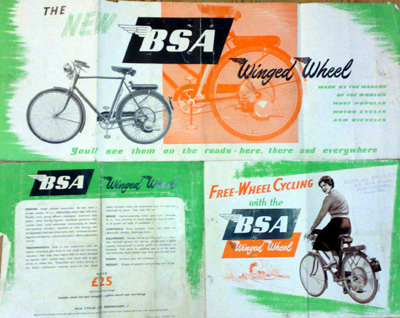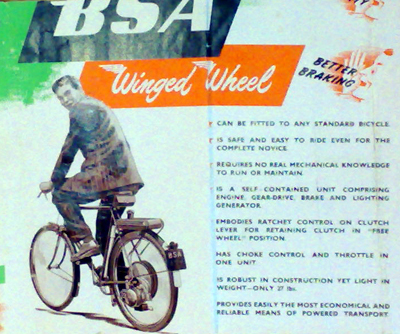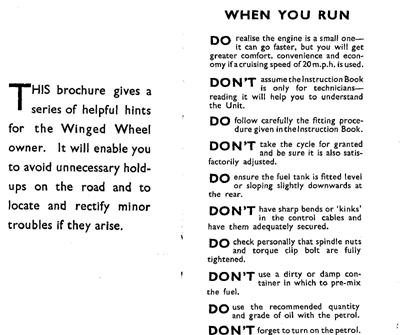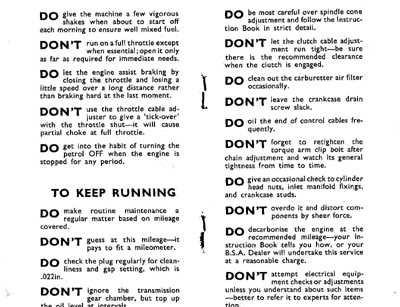1954 BSA Winged Wheel fitted to a 1939 BSA Model T94 Lady-Back Tandem
Sold in Autumn 200. This is its page from http://www.BuyVintage.co.uk, which is where I advertised it.

One of the things I enjoy most about restoring cyclemotors is matching cycle attachment engines to interesting frames. As I collect vintage bicycles such projects are usually within the realms of possibility, though it may take a while to decide on the match. It often involves waking up at 3am thinking something like: ‘Why not put that BSA Winged Wheel into the pre-war BSA Tandem?’
So, may I introduce you to the latest BuyVintage project –
Built in Birmingham…
…Assembled in Sussex

DVLA registered POK 402
Engine number MBW14789
It has just come out of the workshop and, as you can see in the video on www.BuyVIntage.co.uk page 147, starts easily and runs well.
It has been prepared to MOT standard.
The flywheel cover is missing from these photos but I’ve ordered one, which will arrive soon (I was too excited once it was up and running, so had to take photos right away)

According to the logbook the engine is from 1954. BSA introduced them in 1953, and you could fit the engine to your own bicycle.

Included in this sale is a photocopy of the original BSA Winged Wheel Instruction Manual you would have received with the engine. (Don’t strain your eyes: I’ve reproduced close-up pictures at the bottom of this page).

Apart from an engine, what sets a motorcycle apart from a bicycle is the motorcycle’s ability to carry a passenger.
But a tandem is different. Rather than a rider with pillion passenger, as on a motorcycle, a tandem requires a joint effort.
The front rider of a tandem is known as the ‘captain’ or ‘pilot.’ The rear rider is the ‘stoker’ (during the war, known as the ‘tailgunner’).
While a cycle tandem is dependent on both riders always using it together, a motorized tandem can be ridden without the stoker.
But they say a tandem is not a tandem without the stoker.
It’s certainly the combined team that makes tandem riding such a wonderful experience.
The advantage of a bicycle is its lightness and the independence offered to the rider, and it’s obviously much easier to store than a tandem.
Despite these disadvantages, normal vintage tandems are becoming increasingly collectible.
They epitomize a period in Great Britain when cycle touring became very popular.
Many couples in the 1930s used tandems for their holidays, and families would often fit their tandem with a child’s sidecar.

While tandems were most popular before the war, cyclemotor engines such as this were a post-war phenomenon, introduced because new motorcycles were in short supply and bicycles were the most feasible form of transport. Though underpowered two up, fitting a 38cc BSA Winged Wheel to a prewar BSA tandem is therefore totally in keeping with that early 1950s era of austerity.

50-60 years down the road, there are now less than a dozen vintage motorized tandems such as this on the road in Great Britain. I’ve seen Powerpak and Mini-motor engines fitted to tandems, and there are some European versions around (I have a 1951 Narcisse, featured on the http://www.oldbike.eu website). I’m sure someone else must have fitted a Winged Wheel to their BSA Tandem, but I’ve not seen one. So, until proven otherwise, I will declare this pre-war BSA Lady Back Tandem powered by a 1954 BSA Winged Wheel as one of the most novel and interesting machines of its kind in the country.

**********************
BSA MODEL T94 LADY BACK TANDEM
I bought the BSA Lady back Tandem last year. It’s in very good condition and I’ve ridden it. The previous owners used it regularly, and made some modifications for easier cycling. We’ve removed the modern gearing and rear rack seen below to fit the Winged Wheel engine. Non-original items are the front handlebars, handlebar grips and mudguards. I do have original ones on another BSA bicycle but it looks good and rides well as is, so I’ve not disturbed the current set-up.

You can compare it with the 1939 BSA Lady Back tandem illustrated below.

The brochure below is from a few years earlier.



This Winged Wheel engine arrived in running order and DVLA registered, but fitted to a modern bicycle.

So now you can see how and why this project took shape.
*******************
POK 402

What I like most about this rig is that it’s a manageable machine.
I have some French tandems that are really heavy. They are annoying to use for that reason.
This BSA tandem is nowhere near as lumpy, and because this cycle attachment engine fits inside the wheel it is still well-balanced.
Good looks are all very well, but if you can’t use it nobody is going to see it!



Matching Brooks Model B17 saddles at the front, above, and rear, below.

*******************
TANDEM HISTORY
The earliest practical forms of tandem were contemporary with the introduction of the pneumatic tyre, around 1893. Safety bicycles were still a novelty, for the first time allowing ordinary folks to ride a bicycle – the previous style of high wheelers had required athletic ability. So the social aspects of cycling became important at this time, and a tandem obviously allowed a lady and gentleman to ride the same machine.
Early models were designed for the lady to occupy the front saddle. Pioneers of this type of machine were Humber, Singer, Rudge, Raleigh, Whitworth and Chater Lea. Though the lady rider occupied the ‘place of honour’ in front, she’d also be first to impact with any obstacles in the event of a collision.
Steering and balancing were set up for the man behind, and to enable these functions to be controlled from the rear handlebar the two sets of handles had to be connected by a rod on the off side. This arrangement meant that the front rider had handles to hold but was not expected to do any steering or balancing, or she interfered with her partner’s control of the machine, and by ignoring the instructions might cause a spill at a critical moment.
The early frame designs were rather crude, as might be expected, and consisted of a strengthened dropped front frame attached to a rear quadrilateral terminating in the usual rear fork. The rear rider’s pedal crank axle was connected to the front crank axle by a chain, so that the thrust of each rider’s pedals were communicated to the rear road driven wheel. This type of frame was inherently weak, and much binding of chains and bearings caused the machine to run rather hard.
It’s difficult to say who first introduced the lady back tandem, but tandems for two male riders had been in use for a long time before the dropped part of the frame was placed at the rear. Possibly P. L. Renouf made one of the first lady back tandems, at Humber’s Coventry works, but doubtless others claim the innovation as their own.
The design of G. P. Mills, at Raleigh’s Nottingham factory, was regarded as the most scientific type of tandem frame for many years. This frame was triangulated from front to rear and could be ridden by two women, wearing skirts, by a man and woman, or two men.
Illustrated below is the 1910 Chater Lea Lady Back tandem, in this case offered in component form in the Brown Brothers trade catalogue of that year.

In the case of the lady back tandem popular in the twenties and thirties, the rear handle-bar was a fixture, and only the front one was used for steering and balancing in the usual manner.
The increased cost of motoring led to a resurgence of the tandem’s popularity before WW2, though it may seem somewhat incongruous with our 21st century sensibilities to visualize a family tandem with juvenile sidecar.
Nevertheless, I wonder if the austerity of the Great Recession of 2009 will see a new heydey of tandem use?
Q. ‘What did you do in the Great Recession of 2009, Grandad?’
A. ‘We sold the caravan and bought a BSA Winged Wheel Tandem.’
*******************





*******************
THE WINGED WHEEL
The BSA Winged Wheel made its debut in 1953. But within a year the writing was on the wall. New-fangled things called ‘mopeds’ were suddenly all the rage – they were faster, more stable and had gears.
Nevertheless, the Winged Wheel did have the irrefutable name of B.S.A behind it, and no doubt many were sold because of this.
Actually, BSA’s forays into the moped market were not the company’s most successful strategies (the Dandy and the Beagle are prime examples)
The Winged Wheel was the only ‘powerwheel’ available to the British market besides the Cyclemaster. So although, by 1955, cycle attachments were being displaced by mopeds, the Winged Wheel did hang in there for a few years and quite a few were sold.
******************************
The brochures above are reproduced from the Cyclemaster Museum website –
*********
BSA WINGED WHEEL Instruction Manual










